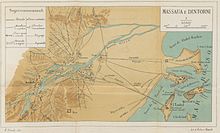MASSAWA
EARLY HISTORY OF MASSAWA

Historical map of Massawa
Massawa was originally a small seaside village, lying in lands coextensive with the
Kingdom of Axum also known as Kingdom of Zula in antiquity and overshadowed by the nearby port of
Adulis about 50 kilometres (31 mi) to the south.
[4]
The city reportedly has the
oldest mosque in
Africa, that is the
Mosque of the Companions (
Arabic:
مسجد الصحابة,
romanized: Masjid aṣ-Ṣaḥābah). It was reportedly built by
companions of Muhammad who escaped
persecution by Meccans.
[5] Following the fall of Axum in the 8th century, the area around Massawa and the town itself became occupied by the Umayyad Caliphate from 702 to 750
CE. The
Beja people would also come to rule within Massawa during the
Bajag Kingdom of Eritrea from the year 740 to the 14th century. Massawa was sited between the sultanates of
Qata,
Baqulin, and
Dahlak.
Midri-Bahri, an Eritrean kingdom (14th–19th centuries), gained leverage at various times and ruled over Massawa. The port city would also come under the supreme control of the Balaw people (people of Beja descent), during the Balaw Kingdom of Eritrea (12th–15th centuries). At this time, the
Sheikh Hanafi Mosque, one of the country's oldest mosque, was built on
Massawa Island, along with several other works of early Islamic architecture both in and around Massawa (including the
Dahlak Archipelago and the
Zula peninsula).
Main sights
Notable buildings in the city include the shrine of
Sahaba,
[13] as well as the 15th century Sheikh Hanafi Mosque and various houses of
coral. Many
Ottoman buildings survive, such as the local
bazaar. Later buildings include the Imperial Palace, built in 1872 to 1874 for
Werner Munzinger; St. Mary's Cathedral; and the 1920s Banco d'Italia. The Eritrean War of Independence is commemorated in a
memorial of three
tanks in the middle of Massawa.
MASSAWA: A FORGOTTEN GEM
EARLY HISTORY OF ADULIS
Pliny the Elder is the earliest writer to mention Adulis (N.H. 6.34). He misunderstood the name of the place, thinking the toponym meant that it had been founded by escaped
Egyptian slaves. Pliny further stated that it was the 'principal mart for the
Troglodytae and the people of
Aethiopia'. Adulis is also mentioned in the
Periplus of the Erythraean Sea, a guide of the
Red Sea and the
Indian Ocean. The latter guide describes the settlement as an emporium for the
ivory, hides, slaves and other exports of the interior. It may have previously been known as
Berenice Panchrysos of the
Ptolemies. Roman merchants used the port in the second and third century AD.
Cosmas Indicopleustes records two inscriptions he found here in the 6th century: the first records how
Ptolemy Euergetes (247–222 BC) used
war elephants captured in the region to gain victories in his wars abroad; the second, known as the
Monumentum Adulitanum, was inscribed in the 27th year of a king of Axum, perhaps named Sembrouthes, boasting of his victories in Arabia and northern Ethiopia.
[2]
A fourth century work traditionally (but probably incorrectly) ascribed to the writer
Palladius of Galatia, relates the journey of an anonymous Egyptian lawyer (
scholasticus) to
India in order to investigate
Brahmin philosophy. He was accompanied part of the way by one Moise or Moses, the Bishop of Adulis.
Control of Adulis allowed Axum to be the major power on the
Red Sea. This port was the principal staging area for
Kaleb's invasion of the
Himyarite kingdom of
Dhu Nuwas around 520. While the scholar
Yuri Kobishchanov detailed a number of raids Aksumites made on the Arabian coast (the latest being in 702, when the port of
Jeddah was occupied), and argued that Adulis was later captured by the
Muslims, which brought to an end Axum's naval ability and contributed to the Aksumite Kingdom's isolation from the
Byzantine Empire and other traditional allies, the last years of Adulis are a mystery. Muslim writers occasionally mention both Adulis and the nearby
Dahlak Archipelago as places of exile. The evidence suggests that Axum maintained its access to the Red Sea, yet experienced a clear decline in its fortunes from the seventh century onwards. In any case, the sea power of Axum waned and security for the Red Sea fell on other shoulders.




No comments:
Post a Comment